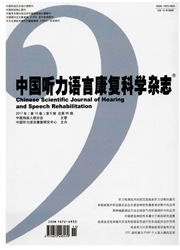

 中文摘要:
中文摘要:
目的分析新疆维吾尔自治区乌鲁木齐市特教学校非综合征性耳聋mtDNA A1555G和C1494T突变情况。方法对194例耳聋学生进行临床资料采集,外周静脉血抽取。血样经基因组DNA提取,进行线粒体DNA12S rRNA A1555G和C1494T突变的直接测序检测。结果194例患者中共发现A1555G突变者18例,C1494T突变者2例,携带率分别为9.28%(18/194)和1.03%(2/194)。有明确氨基糖甙类抗生素应用史的学生中mtDNA A1555G携带率为6.52%(3/46),和没有氨基糖甙类抗生素应用史的患者(15/148)相比差别无统计学意义。新疆两个主要民族汉族和维族mtDNA A1555G携带率无显著性差异。结论mtDNA A1555G突变在新疆地区非综合征性耳聋患者中阳性率很高,高于其他国内外相关报道。mtDNA C1494T突变在新疆耳聋人群中的发生频率很低,可以不考虑列为聋病基因的一线常规检测位点。
 英文摘要:
英文摘要:
Objective To investigate the occlusion effects on elderly people with moderate sensorineural hearing loss and to provide support to reduce the occlusion effect in hearing aids fitting. Methods 30 elderly people with moderate sensorineural hearing loss received both air and bone conduction pure-tone audiometry. The subjects had the earmolds inserted into the ear canals at different positions in relation to the tympanic membranes. Results The values of occlusion effect with the earmold being placed beyond the isthmus of the ear canal 2 mm were significantly different from those with earmolds placed on the isthmus of the ear canal and not reaching the isthmus of the ear canal 2 mm at the frequency of 0.25,0.5 and 1 kHz.There was no significant difference in the occlusion effect between male and female subjects.Conclusion The occlusion effect occurs at the low frequency when the external cartilaginous meatus can vibrate freely.If the earmold reaches the external bony meatus, the occlusion effect will be weakened or eliminated.
 同期刊论文项目
同期刊论文项目
 同项目期刊论文
同项目期刊论文
 Extremely low penetrance of deafness associated with the mitochondrial 12S rRNA mutation in 16 Chine
Extremely low penetrance of deafness associated with the mitochondrial 12S rRNA mutation in 16 Chine Extremely low penetrance of deafness associated with the mitochondrial 12S rRNA T1095C mutation in t
Extremely low penetrance of deafness associated with the mitochondrial 12S rRNA T1095C mutation in t The mitochondrial tRNAAla T5628C variant may have a modifying role in the phenotypic manifestation o
The mitochondrial tRNAAla T5628C variant may have a modifying role in the phenotypic manifestation o Molecular Etiology of Hearing Impairment in Inner Mongolia: mutations in SLC26A4 gene and relevant p
Molecular Etiology of Hearing Impairment in Inner Mongolia: mutations in SLC26A4 gene and relevant p Construction of a multiplex allele-specific PCR-based universal array (ASPUA) and its application to
Construction of a multiplex allele-specific PCR-based universal array (ASPUA) and its application to 期刊信息
期刊信息
